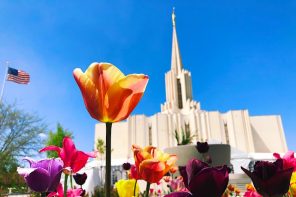Mormon liberals like me are celebrating the LDS Church’s implementation of pilot green building program at five new meetinghouses in Arizona, Nevada, and Utah. Church officials offered tours of a new environment-friendly chapel late last month in Farmington, Utah.
With more than 17,000 buildings around the world—many of them identical down to their industrial carpeting and the art on their Salt Lake City-certified cinder block walls—the Mormon Church has a mighty architectural footprint. If the pilot proves successful, LDS officials promise to implement the green building program for both new construction and chapel retrofitting.
Features of the silver-level LEED certified construction include solar panels, high tech insulation, low-water landscaping, and environment-sensitive irrigation systems. Additionally, display panels installed within the churches report how much energy the wardhouse solar panels are saving in consumer-familiar terms: for example, how many lightbulbs, hair dryers, or toasters conserved energy might fuel.
No word yet on whether the panels may be updated to translate energy savings in terms of Crock Pots or breadmakers, those most beloved of Mormon appliances.
Environmentalism as a form of stewardship for God’s creation has not yet emerged as a feature of theological messaging by top-level LDS leaders, as it has among other communities of Protestants in the U.S. But if these green construction practices become a standard element of the Church’s worldwide building program, the Mormon Church in its own quiet and distinctive way will have joined the creation care movement and set an important example for its 13 million members worldwide.




